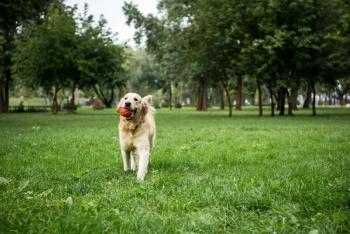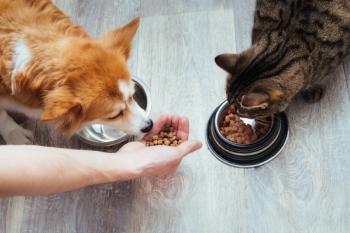
Pet food preferences and transitioning advice

Vicky Ograin, MBA, RVT, VTS, explained the types of foods that appeal to pets and offered tips for making food more palatable to these animals in a Fetch dvm360 Conference lecture
What flavors, textures, and kibble size and shapes do cats and dogs like when it comes to their food? In her session, “Palatability in Pet Food: A Blend of Science and Practice,” presented at the Fetch dvm360 Conference in Atlantic City, New Jersey, Vicky Ograin, MBA, RVT, VTS, scientific communication senior specialist for Hill's Pet Nutrition, talked about canine and feline food preferences, as well as tips for transitioning these animals to therapeutic foods.
In her lecture, Ograin used the hypothetical example of Pearl, a 15-year-old cat that had been diagnosed with renal disease and was recommended to be put on Hill’s Prescription Diet k/d with Chicken Cat Food. Pearl was 11 lbs, had a body condition score of 2 out of 5, and mild muscle loss, explained Ograin. Pearl had been eating regular food her whole life, and was slightly overweight up until her diagnosis, when she began being “a bit of a picky eater.”1
“The other thing to think about with Pearl is: we know that kidney disease can actually affect taste, and so sometimes we have cats or even dogs—but I more think about our cat patients—that have eaten their food their entire lives, and then they're diagnosed with kidney disease, and probably because of the uremia, and [because] they have perhaps…an aversion to that food, [that] maybe they don’t want to eat that food anymore,” explained Ograin, emphasizing that the most important thing with these patients is that they eat.1
When transitioning cats like Pearl to a new food, communication with the client is key. “Our owners don't have the medical knowledge that we do,” said Ograin. She explained that clients should be given an explanation as to why their pet has been put on that food. Ograin recommends sending clients an email or text with the diet information, including feeding instructions and palatability tips.
Transitioning to a new food
When switching cats to a new food, it is important to do so through a transition. The reason for this is because patients should be given time to get used to the new texture and flavor of the new food. When dealing with a change in texture, the transition can range between 1 week to 2 months. However, transitions are generally made to prevent gastrointestinal (GI) upset, for which the transition will typically last 7 days.
“You can start with 75% of the old [food], 25% of the new [food]. What I usually say [is], if I don't see any GI upset, then I go to the next one: 50%. Usually, you're going to see GI upset in that beginning part, and then we go to 25%/75%,” said Ograin.
Feline food preferences
In her session, Ograin shared that cats are very particular about the shapes of their food, being very shape-oriented. These animals prefer crunchy, clean kibbles, and do not like crumbs, also referred to as “fines” in the pet food industry.
Transitioning a cat to a different type of kibble than they have been eating, particularly one that is more rounded, can take 1 to 2 months because they need time to adjust to the new texture and shape. With felines who are used to eating dry food and are being introduced to canned food for the first time, patience is key.
Canine food preferences
Dogs, on the other hand, prefer softer and chewier kibble. Ograin used the analogy of a large, soft Cheeto versus a crunchy Cheeto, explaining that dogs prefer the former. According to Ograin, research has shown that canines—including the smaller breeds— also prefer larger kibble.
Palatability advice
“I always recommend putting the bowls side by side, specifically, when you're changing textures,” explained Ograin. She also recommended warming the food up to body temperature.
Oregano can also be added by squeezing it to bring the oils out. However, it’s important to emphasize to the client that it must be 100% oregano; fresh oregano is best, according to Ograin. “I know that sounds silly, but the amount of owners that use Italian seasonings—it has garlic in it. So, you need to make a point of saying it [needs to be] 100% oregano, no garlic allowed,” emphasized Ograin.
Broth can also be added, ideally low sodium broth. “I tend to go with more low salt, or I make it myself—chicken, beef, fish if you could find a low salt fish one, cats sometimes like that,” said Ograin.
Honey can be used, especially for dogs, although some cats may have a sweet tooth. Ograin recommends mixing a quarter of a teaspoon of honey with water and pouring it over their food.
Lastly, while in the hospital, cats should never be fed the same diet they will be eating at home to avoid creating an aversion to the new diet.
Reference
- Ograin V. Palatability in Pet Food: A Blend of Science and Practice. Presented at: Fetch dvm360 Conference; October 14-16, 2024; Atlantic City, New Jersey.
Newsletter
From exam room tips to practice management insights, get trusted veterinary news delivered straight to your inbox—subscribe to dvm360.






